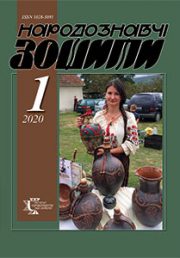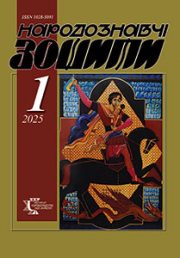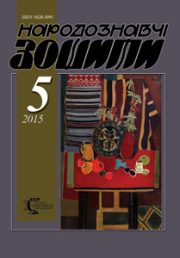The Ethnology Notebooks. 2018, 6 (144), 1439–1447
UDK 801.8 :398.(=161.2)
DOI https://doi.org/10.15407/nz2018.06.1439
Received 21.11.2018
FOLKLORE CONCEPT: THE DEFINITION OF THE TERM, STRUCTURAL PARAMETERS AND TYPES
ORCID ID: https://orcid.org/0000-0002-0512-6388
Kuzmenko Oksana Myroslavivna, candidate of philology sciences (= Ph.D. in philology),
Senior Researcher at the Institute of Ethnology
of the National Academy of Sciences of Ukraine,
Department of Folkloristic,
member and secretary of the folkloristic commission
of the T. Shevchenko Scientific Society,
15 Svobody Avenue, 79000, Lviv, Ukraine.
Contacts: Tel.: 0673505707; e-mail: kuzmenko.oksana@gmail.com
Abstract. The article is devoted to the presentation of the term «concept» as a productive tool not only for philosophical and linguistic disciplines, but also for academic folklore studies. The issue of its specialized variant «folklore concept» is briefly covered. The place of this term in foreign studies and in the Ukrainian scientific discourse has been highlighted. The author’s definition of the term is given and explained. The four-level classification of 12 basic folklore concepts (universal-existential, emotional, character, spatial) has been proposed. They were allocated on the basis ofsructural-semiotic, typological, conceptual and linguistic methods of research of Ukrainian historical folklore of the WWI—WWII period. The author proposes a graphical scheme with the help of which one can illustrate the semiotic model of the experience of the dramatic human existence in the Ukrainian folklore of 20th century.
Keywords: concept, folklore concept, seme, motif, motifeme, thought, experience.
REFERENCES
Ahapkyna, T.A. (2002). Myfopoetycheskye osnovy slavianskoho narodnoho kalendaria. Vesenne-letnyj tsykl. Moskva: Yndryk [in Russian].
Burlaka, N. (2012). Fol’klornyj kontsept «dolia» v usnopoetychnykh tekstakh ta joho retseptsiia u tvorchosti poetiv-romantykiv 20—40-kh rokiv XIX stolittia. Visnyk KNU imeni T. Shevchenka. Literaturoznavstvo. Movoznavstvo. Fol’klorystyka, 23, 41—44 [in Ukrainian].
Harasym, Ya. (2010). Natsional’na samobutnist’ estetyky ukrains’koho pisennoho fol’kloru. L’viv: Ukrains’ki tekhnolohii [in Ukrainian].
Hinda, O. (2015). Kontsept «maty» v ukrains’kykh emihrants’kykh pisniakh. In O. Hinda. Poetychna tvorchist’ ukrains’koi trudovoi spil’noty v Italii pochatku XXII stolittia v konteksti fol’klornoi tradytsii (pp. 231—254). L’viv: LNU im. I. Franka [in Ukrainian].
Hoppal, M. (2006). Semantychna model’ uhors’kykh viruvan’ pro dukha zloho — lidertsa. Narodnatvorchist’ ta etnohrafiia, 4, 23—32 [in Ukrainian].
Mel’nychuk, O.S. (Ed.) (1985). Etymolohichnyj slovnyk ukrains’koi movy: u 7-my t. (Vol. 2D — Koptsi). Kyiv: Naukovadumka [in Ukrainian].
Ivanovs’ka, O. (2012). Ukrains’kyj fol’klor: semantyka i prahmatyka tradytsijnykh smysliv: pidruchnyk. Kyiv: Ekspres-Polihraf [in Ukrainian].
Ivanovs’ka, O.P. (2005). Ukrains’kyj fol’klor i akfunktsional’no-obrazna systema sub’iektnosti: monohrafiia. Kyiv: EksOb [in Ukrainian].
Koval’-Fuchylo, I. (2014). Kontsepty holosyl’noi tradytsii. In I. Koval’-Fuchylo. Ukrains’ki holosinnia: antropolohii a tradytsii, poetyka tekstu (pp. 288—305). Kyiv: IMFE im. M.T. Ryl’s’koho NAN Ukrainy [in Ukrainian].
Kuz’menko, O. (2010). Kontsept BAT’KIVSHCHYNA u paradyhmik hudozhnikh obraziv prostoruv fol’klornykh novotvorakh pro vyselennia (na materiali vlasnykh zapysiv iz Zakhidnoi Bojkivschyny. Literatura. Fol’klor. Problemy poetyky, 34, 210—219 [in Ukrainian].
Kuz’menko, O. (2016). Kontsept «tuha» u pisennosti Druhoi svitovoi vijny: smyslovi dominanty fol’klornoi tradytsii. Mifolohiia i fol’klor, 1—2 (20), 6—26 [in Ukrainian].
Kuz’menko, O. (2018). Kontsept dom v ukraynskyi aprozaychen folklor na p’rvata polovyna na 20 vek: semantyka na «zahubata». Bulgarian folklore, 1, 3—16 [in Bulgarian].
Kuz’menko, O. (2017). Semantyka, typolohiia ta khudozhni formy reprezentatsii fol’klornoho kontseptu «vijna». Literatura. Fol’klor. Problemy poetyky, 42, 68—84 [in Ukrainian].
Kuz’menko, O. (2015). Fol’klornyj kontsept «molytva» v usnij narodnij tvorchosti pro Velyku vijnu: ukrains’kyj dosvid. The Ethnology Notebooks, 2 (122), 283—289 [in Ukrainian].
Kuz’menko, O. (2018). Fol’klorni znaky voiennoho buttia u triadi kontseptiv «volia» — «nevolia» — «dolia». The Ethnology Notebooks, 1 (139), 125—137 [in Ukrainian].
Makkormak, E. (1990). Kohnytyvnaia teoryia metafory. In N.D. Arutiunova (Ed.). Teoryia metafory, 358—386. Moskva: Prohress [in Russian].
Mykytenko, O. (2010). Balkanoslov’ians’kyj tekst pokhoval’noho oplakuvannia: prahmatyka, semantyka, etnopoetyka. Kyiv: IMFE im. M.T. Ryl’s’koho NAN Ukrainy [in Ukrainian].
Mushketyk, L.H. (2010). Liudyna v narodnij kaztsi Ukrains’kykh Karpat: na materiali opovidal’noi tradytsii ukraintsiv ta uhortsiv. Kyiv: IMFE im. M. Ryl’s’koho NAN Ukrainy [in Ukrainian].
Pavlenko, I. (2003). Kontsept slavy v istorychnykh pisniakh. Mova i kul’tura, 6 (t. 3, ch. 1): Linhvokul’turolohichna interpretatsiia tekstu (pp. 332—340). Kyiv: Vyd. Dim Buraho [in Ukrainian].
Pavlenko, I.Ya. (2006). Osnovni konotatsii kontseptiv chasu i prostoru. In I. Ya. Pavlenko. Lehendy ta perekazy Nyzhn’oi Naddniprianschyny: buttia u prostori ta chasi (pp. 166—182). Zaporizhzhia [in Ukrainian].
Panachchio, K. (2011). CONCEPTUS, kontsept, poniattia. In B. Kassen (Ed.). Yevropejs’kyj slovnyk filosofij. Leksykon neperekladnostej: u 3 t. (vol. 1, ed. 2, pp. 279—283). Kyiv: Dukhilitera [in Ukrainian].
Pyrs, Ch.S. (2009). Chto takoe znak? (transl. from english A.A. Arhamakova). Vestnyk Tomskoho gosudarstvennogo universiteta. Seria. Fylosofyia. Sotsyolohyia. Polytolohyia, 3 (7), 88—95 [in Russian].
Stavyts’ka, Ya. (2016). Kontsept dushi v ukrains’kykh snotlumachenniakh kintsia 19 — pochatku 20 stolittia. Naukovi zapysky Ternopil’skoho Natsional’noho Universytety im. V. Hnatiuka, 44, 77—81 [in Ukrainian].
Tarasiuk, I. (2012). Kontsept nadii v ukrains’kij narodno-relihijnij dukhovnosti: na materiali paremij. The Ethnology Notebooks, 6 (108), 1027—1041 [in Ukrainian].
Tolstaia, S.M. (2013). Kody kul’tury i kul’turnye kontsepty. In Tolstoj N.Y., & Tolstaia S.M. Slavianskaia etnolynhvystyka: voprosy teoryy (pp. 109—114). Moskva: Ynstytut slavianovedenyia RAN [in Russian].
Usatenko, T., & Usatenko, H. (2012). Kontsept «kordotsentryzm» u konteksti tsinnostej osobystosti. Estetyka i etyka pedahohichnoi dii, 4, 28—40 [in Ukrainian].
Shevchuk, T. (2014). Kontsept svitla v ukrains’kykh narodnykh dumakh (mifolohichni struktury v dumi pro Marusiu Bohuslavku). In M.K. Dmytrenkj (Ed.). Ukrains’kyj fol’klor: metodolohiia doslidzhennia, dynamika funktsionuvannia (pp. 71—89). Kyiv: Palyvoda A.V. [in Ukrainian].
Yudyn, A. (2008). Kontsept chuzhbyna / chuzhyna v russkomy ukraynskom iazykakh: sopostavytel’nyj analyz. Etnolingwistyka, 20, 77—94 [in Russian].
Yarmolenko, N. (2011). Transformatsii mifolohichnoi opozytsii «khaos — kosmos» v ukrains’kij kul’turnij tradytsii. Visnyk Cherkas’koho universytetu. Seriia filolohichna, 198, 166—170 [in Ukrainian].
Nichols, S. (2004). Folk concepts and intuitions: From philosophy to cognitive science. Trends in Cognitive Sciences, vol. 8, issue. 11, 514—518 [in English]
Concepts. (2011). In Stanford Encyclopedia of Philosophy. Retrieved from http://seop.illc.uva.nl/entries/concepts/ [in English].
Racenaite, R. (2013). Folklor in ėatmintis: retrospekty vussanty kissuvieta lietuvi ųliaudiessakmėse. Tautosakosdarbai, XLVI, 107—131. Retrieved from http://www.llti.lt/failai/09_Racenaites.pdf [in Lithuanian].
Zakal’s’ka, Ya. (2015). Substantsijna skladova u tradytsii povstans’koho fol’kloru. In Materialy naukovo-praktychnoi konferentsii «Vos’mi vseukrains’ki naukovi fol’klorystychni chytannia, prysviacheni profesoru Lidii Dunaievs’kij», 5—7. Retrieved from http://philology.knu.ua/sites/default/files/materialy%202015.pdf[in Ukrainian].
Kerymbaev, E.A., & Erhubekova, Zh.S. (2012). Kohnytyvnye i lynhvokul’turolohycheskye aspekty i issledovanyia kontseptov epycheskoho fol’klora. In Uspekhy sovremennoho estestvoznanyia. Ser. Fylolohycheskye nauky, 7, 97—103 Retrieved from www.rae.ru/use/pdf/2012/7/19.pdf[in Russian].
Levynton, H.A. (2000). «Yntertekst» v fol’klore. In Folklore in 2000. Vocesamicorum Guilhelmo Voigt sexagenario (pp. 21—28). Budapest. Retrieved from http://www.ruthenia.ru/folklore/levinton1.htm [in Russian].
Nekliudov, S. (2002). Fol’klor: typolohycheskyj i kommunykatyvnyj aspekty // Tradytsyonnaia kul’tura, 3, 3—7. Retrieved from http://www.rutenia.ru\folklore\necludov15.htm [in Russian].
Chernousova, Y.P. (2012). Spetsyfyka kontsepta PEChAL’ v fol’klorno-iazykovoj kartyne myra (na materyale epycheskykh zhanrov). Fylolohycheskye nauky, oktobr. Retrieved from http://research-journal.org/featured/languages/specifika-koncepta-pechal-v-folklorno-yazykovoj-kartine-mira-na-materiale-epicheskix-zhanrov [in Russian].
Emer, Yu.A. (2011). Myromodelyrovanye v sovremennom pesennom fol’klore: kohnytyvno-dyskursyvnyj analyz (Avtoref dys. Doc. fylol. nauk). Tomskyj hosudarstvennyj unyversytet. Tomsk. Retrieved from http://www.dissercat.com/content/miromodelirovanie-v-sovremennom-pesennom-folklore-kognitivno-diskursivnyi-analiz [in Russian].
Emer, Yu.A. (2010). Fol’klornyj kontsept: zhanrovo-dyskursyvnyj aspect. Vestnyk Tomskoho hosudarstvennoho unyversyteta. Ser. Philology, 1 (9), 91—99. Retrieved from https://cyberleninka.ru/article/n/folklornyy-kontsept-zhanrovo-diskursivnyy-aspekt [in Russian].







